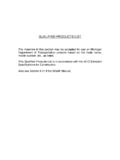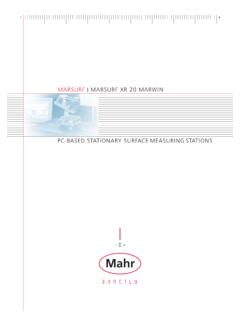Transcription of The Profile XT Technical Manual - LMI-CEO
1 The Profile XT. Technical Manual September 2006. Assessments USA & Canada 800-808-6311 805-934-5956. The ProfileXT Technical Manual Table of Contents Chapter 1: 1-1. Using Job Match Patterns ..1-2. Illustrations of The ProfileXT in Use ..1-4. The First Example ..1-4. The Second Example ..1-5. A Summary of the The Sales Organization ..1-6. The Government Chapter 2: DEVELOPMENT of the PXT ..2-1. The Behavioral Traits Section ..2-1. PS-I and PS-II ..2-1. Revision of PS-I ..2-1. Addition of the Decisiveness and Manageability Scales ..2-3. Development of the Distortion The ProfileXT ..2-5. Occupational Interests Factor Analysis ..2-7. ProfileXT: Occupational Interests Section A Focus on Common Activities ..2-9. Interest Theme Coding ..2-10. Item The Thinking Style Changing the Timing Aspect in Test Administration ..2-12. Government Guidelines ..2-13. Administration Problems with Timed Tests.
2 2-13. Utilizing Resources for On-line Testing Administration ..2-14. Chapter 3: BEHAVIORAL Descriptive Statistics ..3-1. Reliability Analysis ..3-1. Coefficient Alpha Reliability Test-Retest Reliability Analysis ..3-3. Validity ..3-3. The Construct Validity Approach ..3-4. Intercorrelation of PXT Scales ..3-4. Energy Level and Decisiveness Scales ..3-5. Assertiveness and Decisiveness Manageability and Attitude Independence and Manageability Scales ..3-7. Correlation of PXT Scales with Other The Guilford-Zimmerman Temperament Survey ( Gordon Personal Profile -Inventory ( -1- The ProfileXT Technical Manual California Psychological Inventory ( The Criterion-Related Validity Research Designs Used For Criterion-Related Validation3-14. Concurrent Validity ..3-14. Predicting Sales Performance ..3-15. Predicting Customer Service Performance ..3-18. Predicting Management Performance ..3-19.)))
3 Predicting Predicting Employee Predicting Organization Status ..3-25. Validation of the Distortion Adverse Impact ..3-29. Differences in Mean Raw Score ..3-30. Differences in Job Match Percent ..3-31. Summary and Conclusions ..3-33. Chapter 4: OCCUPATIONAL INTERESTS ..4-1. Descriptive Statistics ..4-1. Reliability Analysis ..4-1. Coefficient Alpha Reliability Test-Retest Reliability Analysis ..4-2. Validity ..4-2. The Construct Validity Approach ..4-2. Intercorrelation of PXT Scales ..4-3. Correlation Matrix-Six Occupational Scales: SDS & PXT ..4-4. Correlation Matrix-Six Occupational Scales: PTP & PXT ..4-5. Concurrent Validity ..4-6. Summary of Concurrent Validity Analysis ..4-10. Predictive Validity ..4-11. Adverse Impact Raw Score Differences ..4-12. Differences in Job Match Percent ..4-14. Summary and Conclusions ..4-16. Chapter 5: THINKING Descriptive Statistics ..5-1. Reliability Analysis.
4 5-1. Test-Retest Reliability Analysis ..5-2. Validity ..5-3. Validity in the Educational Environment ..5-3. Validity in the Industrial Adverse Impact ..5-5. Raw Score Differences in Job Match Summary and Conclusions ..5-8. -2- The ProfileXT Technical Manual Appendix A: A BRIEF REVIEW of the Profile Appendix A-1. Behavioral Traits .. Appendix A-1. Thinking Style Scales .. Appendix A-4. Occupational Interests .. Appendix A-4. The Distortion Scale .. Appendix A-6. Appendix B: ADVERSE IMPACT PXT and the 4/5ths Appendix B-1. Appendix B-1. Test Appendix B-1. Understanding the Job Match Percent .. Appendix B-3. Job Classification and Appendix B-3. Utilizing Job Patterns-Their Effect Upon Adverse Appendix B-12. Subsequent Salesperson Study .. Appendix B-16. Appendix C: ADVERSE IMPACT and RAW Appendix C-1. Raw Score Differences Behavioral Appendix C-1. Raw Score Differences Interest Appendix C-20.
5 Raw Score Differences Thinking Style Section .. Appendix C-32. Appendix D: ADVERSE IMPACT and JOB MATCH Appendix D-1. Appendix E: CASE Appendix E-1. The ProfileXT in use by a Credit Union .. Appendix E-1. The ProfileXT in use by a Psychiatric Appendix E-2. The ProfileXT in use by a Travel Agency .. Appendix E-3. The ProfileXT in use by a Retail Appendix E-5. The ProfileXT in use by a Hospital .. Appendix E-6. The ProfileXT in use by an Oil Field Service Appendix E-7. Appendix F: EXAMPLES of the ProfileXT REPORTS ..Appendix F-1. Bibliography -3- THE Profile XT Technical Manual . Chapter 1: INTRODUCTION. This Technical document was revised in 2005 to reflect the latest information available concerning our ongoing analysis of the Profile XT. Further statistical and Technical review will continue, as required, in our effort to keep the assessment and its Technical documentation current.
6 Changes to this document include slight reorganization of the chapters, updates to the statistical studies with current data, and editorial content improvements. In the business world, where it is so easy to duplicate products and undercut prices, the key strategic advantage for most companies is the performance of their employees. Employees who are well matched to their position have higher attendance records, less turnover, higher job satisfaction, and superior job performance. Both the employee and the employer share the benefits of enhanced person-job fit. As part of the Profiles International, Inc. line of products for employers, The Profile XT . is designed to facilitate achieving the best possible job fit. Our clients use The Profile XT to develop effective work teams, design optimal training programs based on the trainees' style of learning, help supervisors determine which approach will work best when working with a particular employee, and help develop succession plans, etc.
7 The Profile XT is a psychometric instrument whose roots extend over the last twenty- five years. More than two hundred thousand job applicants and incumbents have participated in its development. These sample groups represent a diverse cross section of ages, ethnic groups, income levels, educational levels, job titles, companies, and industries. The Profile XT is the product of collaboration between several test development psychologists and specialists coordinated by Profiles International, Inc. The Profile XT investigates several areas as a part of evaluating how an individual fits into a particular job. These areas are composed of a variety of constructs measured as ten-point standardized scales. Each scale represents a construct related to one of three areas and theories: 1. Behavioral Traits: The psychological premises of Adler, Beck, and Ellis that observable behavior is a reflection of cognitive states 2.
8 Occupational Interests: Holland's person-environment typology theory that one's motivation for work can be associated with various categories Copyright 1999-2006 800-808-6311. 1-1. THE Profile XT Technical Manual . 3. Thinking Style: Cognitive Learning Theory that cognitive processes are reflected in one's style of learning In general, the overriding theme of the PXT scales lies in Cognitive Psychology: conclusions about unobservable cognitive processes can often be drawn from objective, methodical observations of people's behavior. The act of reporting one's behavior is a reflection of the total person within, which partially determines one's fit for a number of work environments. To create scales that measure constructs relevant to both our underlying theoretical perspective and our focus on the core of work-related behavior, a substantial pool of items was developed, administered, and factor analyzed.
9 The resultant constructs that we identified satisfied our conceptual and practical needs, without creating an overly complex assessment of the countless layers of human personality. In other words, while personality may be described in a great number of constructs, a practical compromise was to focus on nine essential aspects of behavior, six occupational interests, and five measures of learning potential. Our practical intent is to provide the business community with an easy-to-administer assessment of relevant, work-related constructs that describe the working individual. These constructs, as measured by the PXT scales, provide the assessment user with a variety of relevant and applicable questions with which to interact with a candidate. Reliability and construct validity analyses met with our expectations, revealing coherent, consistent, and practical scales with which to measure the working population.
10 The Profile XT investigates several areas (Behavioral Traits, Occupational Interests, and Thinking Style) as a part of evaluating how an individual fits into a particular job. By reviewing broad areas of occupational interests, behavioral traits, and thinking style, we expand our ability to discover which areas will be most effective in determining job fit for a given position. By attending to each of the three areas, we enhance the opportunity to identify the factors that will lead to the best job fit. Using Job Match Patterns Several scales are utilized in the Profile XT to determine job fit. Because these scales apply to various job competencies in a variety of ways, depending on the specific job and work environment of each client, a Job Match Pattern is needed. By standardizing Copyright 1999-2006 800-808-6311. 1-2. THE Profile XT Technical Manual . the job fit process, Job Match Patterns reveal more than individual scores on each scale alone.


